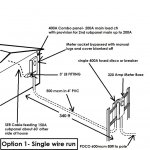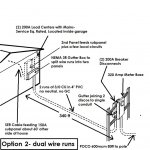rjmeyer
Member
- Location
- Washington State
I am running into fits with this project. I am familiar with "typical" 320 Amp residential services where a dual-lug meter base (often on an exterior wall) feeds two adjacent 200 Amp panels (usually mounted indoors, opposite the meter base).
That's a fairly straightforward arrangement. My current project, however, involves some difficulties I cannot seem to arrive at answers for. It all involves stuff on the load side of the meter, so I do not think the POCO will feel like weighing in. I figure I may need to run this by the inspector, but I want to do so intelligently only after researching my options.
As for the difficulties, here's how it differs from most situations: We are working on a 4200 sq. ft. house in a rural setting. The physical arrangement of the site, and the owner's preference, made POCO access to the house itself difficult. We decided the best place to locate the meter base was at the loop drive access about 300 feet from the house. The POCO ran their conductors underground to this meter base, which is mounted on a uni-strut rack. Per NEC sec. 220 our load calc puts us at about 240 Amps. We also want to allow for additional capacity for future needs. After discussing the project with the POCO engineers, we opted against a 400 Amp service for two reasons: First it would require Current Transformer metering- no big deal, just additional equipment and cost. Second, with the length of the run, they would have had to run their primaries underground and provide a transformer pad closer to the building- something else the owners do not want.
So we now have a 320 Amp underground supplied meter base mounted remote about 340 feet from the house. We have 340 feet of 4" PVC conduit from that meter base to the house. Based on the distance from the meter to the house, my first thought was to up the conductors to 500kcmil to compensate for voltage drop, to feed a 320/400 amp load center with 200 Amp main and 200 Amp sub-feed to a second load center interior to the house.
I have found panels that accommodate such an arrangement- basically 400/320A rated with lugs able to accommodate a single pair of 500 kcmil conductors, and then basically having one 200A main to feed a subpanel, with the bus then feeding straight down to a second 200 amp main for the load center itself. It is a neat arrangement, however most of the panels I have found with such an arrangement are all built with the meter socket integral to the panel. I have found one such panel made by Murray(Siemens) with the accommodation for two 200 Amp mains, one for the load center and one for a subpanel and no meter socket, but their lead time on delivering that panel is eight weeks. I am also starting to be a little mystified by the nomenclature- some panels are Meter-Main, other are called Combination Panels- don't know which might specifically refer to what I am trying to do.
So my questions are: Is there a "typical" way of feeding a service from a meter base mounted hundreds of feet from the building? Do those service conductors need a disconnecting means at the meter? (230.91, 230.71)(and/or overcurrent protection?) Is it acceptable or is it normal practice to bypass a meter socket with bypass lugs and blank off the opening in situations where no meter is being used at the building, or as in my case where the meter is located remotely? I know most meter bases provide means for a temporary bypass when the meter is being installed/removed, but I am not sure if the manual bypass lugs I am thinking of are intended to be installed as a means of permanently bypassing the meter socket when no meter is to be used at the panel.
So again in short- The house has already had 320 Amp service pulled to a meter base 340 feet from the building. Service to the meter is underground. Feeders from the meter will be underground in 4" PVC- this conduit is already in place. We want to avoid two parallel wire runs between the meter and the house- would prefer a single larger run (500 kcmil). The meter base currently does not have its own disconnect, but there is room for one adjacent to the meter base. We are trying to provide one 200 Amp panel in the garage and a 150 or 200 Amp subpanel about 60 feet to the other end of the residence. How might you approach this if it were your project? I have hung lots of 200A panels on houses, outbuildings and such, but this remote meter base thing has me stumped.
I know this has been a long post- I hope I was clear in describing what we are trying to do- any help is much appreciated.
Rob
That's a fairly straightforward arrangement. My current project, however, involves some difficulties I cannot seem to arrive at answers for. It all involves stuff on the load side of the meter, so I do not think the POCO will feel like weighing in. I figure I may need to run this by the inspector, but I want to do so intelligently only after researching my options.
As for the difficulties, here's how it differs from most situations: We are working on a 4200 sq. ft. house in a rural setting. The physical arrangement of the site, and the owner's preference, made POCO access to the house itself difficult. We decided the best place to locate the meter base was at the loop drive access about 300 feet from the house. The POCO ran their conductors underground to this meter base, which is mounted on a uni-strut rack. Per NEC sec. 220 our load calc puts us at about 240 Amps. We also want to allow for additional capacity for future needs. After discussing the project with the POCO engineers, we opted against a 400 Amp service for two reasons: First it would require Current Transformer metering- no big deal, just additional equipment and cost. Second, with the length of the run, they would have had to run their primaries underground and provide a transformer pad closer to the building- something else the owners do not want.
So we now have a 320 Amp underground supplied meter base mounted remote about 340 feet from the house. We have 340 feet of 4" PVC conduit from that meter base to the house. Based on the distance from the meter to the house, my first thought was to up the conductors to 500kcmil to compensate for voltage drop, to feed a 320/400 amp load center with 200 Amp main and 200 Amp sub-feed to a second load center interior to the house.
I have found panels that accommodate such an arrangement- basically 400/320A rated with lugs able to accommodate a single pair of 500 kcmil conductors, and then basically having one 200A main to feed a subpanel, with the bus then feeding straight down to a second 200 amp main for the load center itself. It is a neat arrangement, however most of the panels I have found with such an arrangement are all built with the meter socket integral to the panel. I have found one such panel made by Murray(Siemens) with the accommodation for two 200 Amp mains, one for the load center and one for a subpanel and no meter socket, but their lead time on delivering that panel is eight weeks. I am also starting to be a little mystified by the nomenclature- some panels are Meter-Main, other are called Combination Panels- don't know which might specifically refer to what I am trying to do.
So my questions are: Is there a "typical" way of feeding a service from a meter base mounted hundreds of feet from the building? Do those service conductors need a disconnecting means at the meter? (230.91, 230.71)(and/or overcurrent protection?) Is it acceptable or is it normal practice to bypass a meter socket with bypass lugs and blank off the opening in situations where no meter is being used at the building, or as in my case where the meter is located remotely? I know most meter bases provide means for a temporary bypass when the meter is being installed/removed, but I am not sure if the manual bypass lugs I am thinking of are intended to be installed as a means of permanently bypassing the meter socket when no meter is to be used at the panel.
So again in short- The house has already had 320 Amp service pulled to a meter base 340 feet from the building. Service to the meter is underground. Feeders from the meter will be underground in 4" PVC- this conduit is already in place. We want to avoid two parallel wire runs between the meter and the house- would prefer a single larger run (500 kcmil). The meter base currently does not have its own disconnect, but there is room for one adjacent to the meter base. We are trying to provide one 200 Amp panel in the garage and a 150 or 200 Amp subpanel about 60 feet to the other end of the residence. How might you approach this if it were your project? I have hung lots of 200A panels on houses, outbuildings and such, but this remote meter base thing has me stumped.
I know this has been a long post- I hope I was clear in describing what we are trying to do- any help is much appreciated.
Rob



